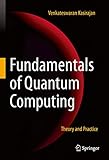Fundamentals of quantum computing: theory and practice
Material type: TextPublication details: Switzerland Springer 2021 Description: xxix, 463 pISBN: 9783030636883Subject(s): Quantum computing | Quantum computers | Quantum theory | AlgorithmsDDC classification: 004.0151 Summary: About this book
This introductory book on quantum computing includes an emphasis on the development of algorithms. Appropriate for both university students as well as software developers interested in programming a quantum computer, this practical approach to modern quantum computing takes the reader through the required background and up to the latest developments.
Beginning with introductory chapters on the required math and quantum mechanics, Fundamentals of Quantum Computing proceeds to describe four leading qubit modalities and explains the core principles of quantum computing in detail. Providing a step-by-step derivation of math and source code, some of the well-known quantum algorithms are explained in simple ways so the reader can try them either on IBM Q or Microsoft QDK. The book also includes a chapter on adiabatic quantum computing and modern concepts such as topological quantum computing and surface codes.
Features:
o Foundational chapters that build the necessary background on math and quantum mechanics.
o Examples and illustrations throughout provide a practical approach to quantum programming with end-of-chapter exercises.
o Detailed treatment on four leading qubit modalities -- trapped-ion, superconducting transmons, topological qubits, and quantum dots -- teaches how qubits work so that readers can understand how quantum computers work under the hood and devise efficient algorithms and error correction codes. Also introduces protected qubits - 0-π qubits, fluxon parity protected qubits, and charge-parity protected qubits.
o Principles of quantum computing such as quantum entanglement, no-cloning theorem, quantum teleportation, quantum interference, superdense coding, quantum parallelism, and adiabatic quantum computing.
TextPublication details: Switzerland Springer 2021 Description: xxix, 463 pISBN: 9783030636883Subject(s): Quantum computing | Quantum computers | Quantum theory | AlgorithmsDDC classification: 004.0151 Summary: About this book
This introductory book on quantum computing includes an emphasis on the development of algorithms. Appropriate for both university students as well as software developers interested in programming a quantum computer, this practical approach to modern quantum computing takes the reader through the required background and up to the latest developments.
Beginning with introductory chapters on the required math and quantum mechanics, Fundamentals of Quantum Computing proceeds to describe four leading qubit modalities and explains the core principles of quantum computing in detail. Providing a step-by-step derivation of math and source code, some of the well-known quantum algorithms are explained in simple ways so the reader can try them either on IBM Q or Microsoft QDK. The book also includes a chapter on adiabatic quantum computing and modern concepts such as topological quantum computing and surface codes.
Features:
o Foundational chapters that build the necessary background on math and quantum mechanics.
o Examples and illustrations throughout provide a practical approach to quantum programming with end-of-chapter exercises.
o Detailed treatment on four leading qubit modalities -- trapped-ion, superconducting transmons, topological qubits, and quantum dots -- teaches how qubits work so that readers can understand how quantum computers work under the hood and devise efficient algorithms and error correction codes. Also introduces protected qubits - 0-π qubits, fluxon parity protected qubits, and charge-parity protected qubits.
o Principles of quantum computing such as quantum entanglement, no-cloning theorem, quantum teleportation, quantum interference, superdense coding, quantum parallelism, and adiabatic quantum computing.
| Item type | Current library | Collection | Call number | Copy number | Status | Date due | Barcode |
|---|---|---|---|---|---|---|---|
 Book
Book
|
Indian Institute of Management LRC General Stacks | IT & Decisions Sciences | 004.0151 KAS (Browse shelf(Opens below)) | 1 | Available | 002809 |
About this book
This introductory book on quantum computing includes an emphasis on the development of algorithms. Appropriate for both university students as well as software developers interested in programming a quantum computer, this practical approach to modern quantum computing takes the reader through the required background and up to the latest developments.
Beginning with introductory chapters on the required math and quantum mechanics, Fundamentals of Quantum Computing proceeds to describe four leading qubit modalities and explains the core principles of quantum computing in detail. Providing a step-by-step derivation of math and source code, some of the well-known quantum algorithms are explained in simple ways so the reader can try them either on IBM Q or Microsoft QDK. The book also includes a chapter on adiabatic quantum computing and modern concepts such as topological quantum computing and surface codes.
Features:
o Foundational chapters that build the necessary background on math and quantum mechanics.
o Examples and illustrations throughout provide a practical approach to quantum programming with end-of-chapter exercises.
o Detailed treatment on four leading qubit modalities -- trapped-ion, superconducting transmons, topological qubits, and quantum dots -- teaches how qubits work so that readers can understand how quantum computers work under the hood and devise efficient algorithms and error correction codes. Also introduces protected qubits - 0-π qubits, fluxon parity protected qubits, and charge-parity protected qubits.
o Principles of quantum computing such as quantum entanglement, no-cloning theorem, quantum teleportation, quantum interference, superdense coding, quantum parallelism, and adiabatic quantum computing.

There are no comments on this title.